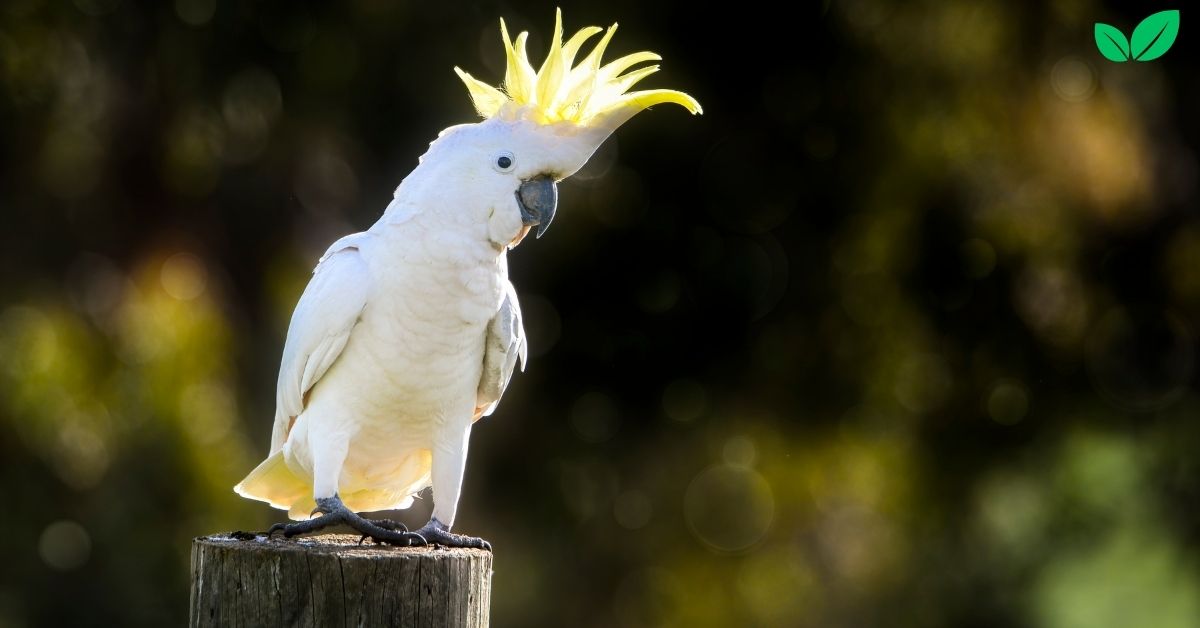The White Cockatoo, also known as Cacatua alba or the Umbrella Cockatoo, is a striking parrot species native to the tropical rainforests of Indonesia. With its all-white plumage and iconic crest that resembles an umbrella when raised, this bird is highly recognized in aviculture and conservation. Beyond its physical beauty, Cacatua alba plays a vital role in its natural habitat, contributing to forest health, supporting biodiversity, and maintaining ecological balance in its ecosystem.
This article explores the environmental niche of Cacatua alba, delving into its habitat, physical characteristics, ecological roles, interactions with other species, and the challenges it faces due to habitat loss and illegal pet trade. By understanding the ecological significance of the White Cockatoo, we can better appreciate its role in maintaining biodiversity and the importance of its conservation.
Overview of Cacatua Alba: Characteristics and Habitat
Cacatua alba, part of the Psittacidae family, is known for its striking appearance, intelligence, and vocal personality. Endemic to a specific range within Indonesia, this bird is primarily found on the Maluku Islands, including Halmahera, Ternate, and Tidore. The White Cockatoo thrives in the humid, tropical forests of these islands, where it performs various ecological functions.
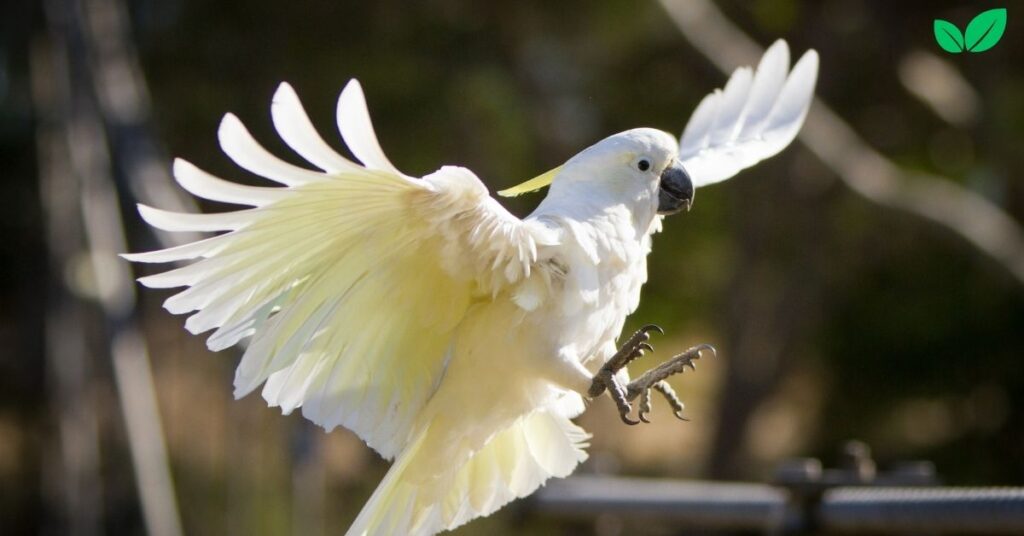
1. Physical Characteristics
The White Cockatoo is medium-sized, measuring approximately 18 inches in length, with a wingspan of around 34 inches. Its all-white feathers, crested head, and dark gray to black beak give it a distinct and elegant appearance. When excited or alarmed, it raises its crest, forming an umbrella-like fan that adds to its appeal and has earned it the nickname “Umbrella Cockatoo.”
Its powerful beak allows it to crack hard seeds and nuts, which are primary components of its diet, along with fruits, berries, and insects. The bird’s zygodactyl feet, meaning it has two toes facing forward and two backward, make it an excellent climber, allowing it to maneuver through the canopy with ease.
2. Native Habitat and Range
Cacatua alba inhabits the dense tropical rainforests of Indonesia’s Maluku Islands, where it is most commonly found in lowland forests, mangrove forests, and coastal forest areas. It favors regions with tall trees, providing ample nesting and foraging opportunities. This bird is adapted to life in the forest canopy, where it spends much of its time searching for food, socializing with other cockatoos, and seeking shelter from predators.
Though the White Cockatoo primarily inhabits rainforests, it has shown adaptability by occupying secondary forests and partially disturbed areas, as long as adequate food and nesting resources are available. However, its reliance on mature trees for nesting means that extensive deforestation poses a significant threat to its population.
Adaptations of Cacatua Alba to Its Environment
Cacatua alba possesses several adaptations that enable it to thrive in the tropical rainforest environment. These adaptations include a specialized diet, social behavior, and an impressive vocal ability, all of which play roles in its survival and ecological functions.
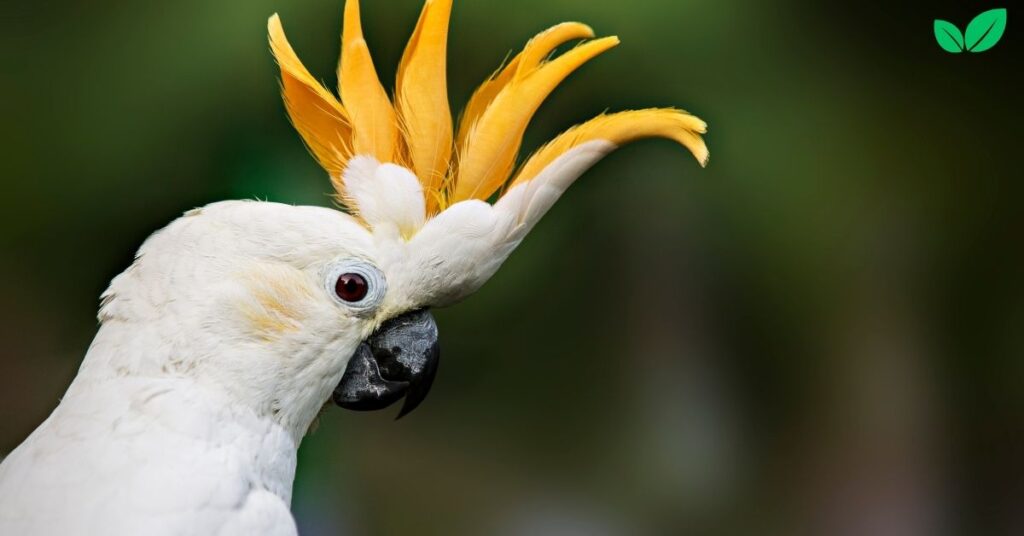
1. Specialized Beak for Seed and Nut Feeding
The White Cockatoo’s beak is exceptionally strong, allowing it to crack open hard nuts and seeds that other animals might find challenging. This diet provides it with essential nutrients and supports its high energy needs. The bird’s powerful beak is also used to break down fruits and access seeds inside, which aids in nutrient cycling within the forest ecosystem.
This dietary specialization is crucial for the White Cockatoo’s role as a seed disperser, as it consumes fruits and nuts from various plant species and disperses the seeds through its droppings or by dropping partially eaten fruits. This seed dispersal contributes to the regeneration of forest plants and helps maintain biodiversity within its habitat.
2. Social Behavior and Flocking
Cacatua alba is a highly social bird that often travels in flocks, especially outside the breeding season. These flocks can range from small family groups to larger gatherings, which helps protect individuals from predators and improves foraging efficiency. Social behavior also strengthens bonds within groups and enables juvenile birds to learn essential survival skills from adults.
By foraging in groups, the White Cockatoo helps ensure efficient resource use within its habitat, as the group can locate and access food sources more easily. Socialization also provides protection through a group’s vigilance, as multiple eyes can watch for potential predators, such as hawks or snakes, that threaten the birds within the dense canopy.
3. Vocalization for Communication and Territory Defense
The White Cockatoo is known for its loud and complex vocalizations, which it uses to communicate with other members of its flock and to defend its territory. These vocalizations range from high-pitched screeches to softer calls and are essential for coordinating group movements, alerting other birds to food sources, and signaling alarm when predators are nearby.
Its vocal abilities also allow it to establish territories and assert dominance within its habitat. These vocalizations play a role in maintaining social structures within flocks, supporting cooperation, and ensuring that cockatoos can communicate over long distances in the dense rainforest environment.
Ecological Roles and Contributions of Cacatua Alba
The White Cockatoo plays a significant ecological role in its environment, contributing to forest health, supporting biodiversity, and promoting nutrient cycling. Its behaviors and interactions with plants and other animals highlight its importance within tropical ecosystems.
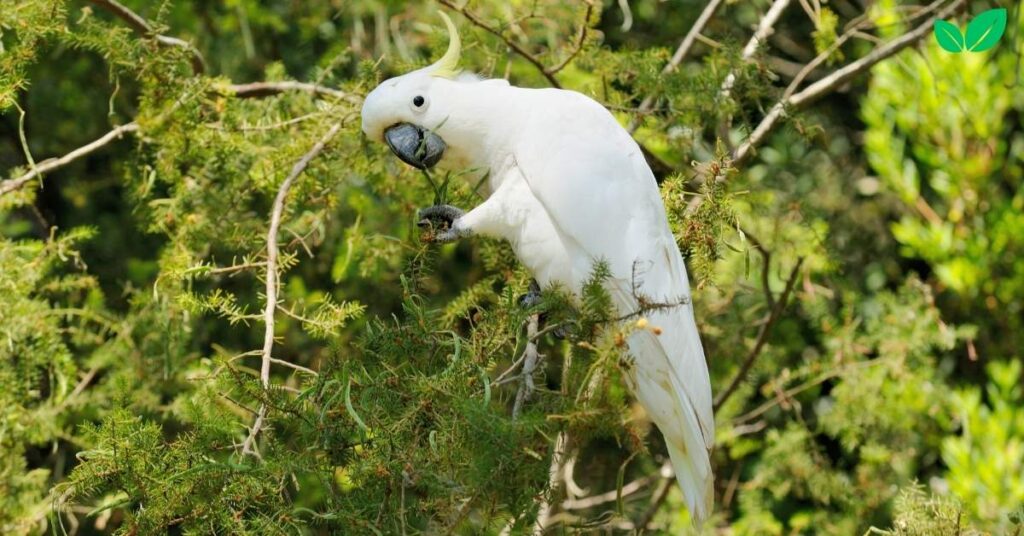
1. Seed Dispersal and Forest Regeneration
One of the most important ecological roles of the White Cockatoo is seed dispersal. By consuming fruits and seeds, this bird helps disperse the seeds of various plant species throughout the forest. Some seeds pass through the digestive system intact, while others are dropped while the bird is feeding. This seed dispersal contributes to forest regeneration by allowing plants to establish in new areas, promoting genetic diversity, and supporting the growth of different plant species within the forest.
The bird’s role as a seed disperser is essential for the health of tropical forests, where biodiversity relies on the continuous regeneration of plant species. By facilitating seed dispersal, the White Cockatoo aids in maintaining species diversity and supporting a balanced ecosystem within its habitat.
2. Nutrient Cycling and Soil Enrichment
As the White Cockatoo consumes various fruits, seeds, and insects, it contributes to nutrient cycling within the forest ecosystem. By dropping fruit pieces, leaves, and other organic matter, the cockatoo enriches the forest floor with nutrients that decompose and are absorbed by plants. This decomposition process supports microbial life in the soil, enhancing soil fertility and promoting the growth of understory vegetation.
The bird’s waste also adds nutrients to the soil, providing essential minerals for plant growth. This nutrient cycling process is crucial in tropical forests, where rapid decomposition and nutrient uptake by plants create a dynamic and balanced ecosystem.
3. Supporting Biodiversity and Ecosystem Balance
The presence of Cacatua alba within tropical rainforests contributes to biodiversity and helps maintain ecological balance. As both a predator of seeds and a prey species for larger birds, reptiles, and mammals, the White Cockatoo is a valuable component of the food web. Its interactions with other species, such as the plants it pollinates and the predators that hunt it, support a balanced ecosystem with diverse trophic relationships.
The White Cockatoo’s role in supporting biodiversity also extends to its influence on other bird species, as it helps control insect populations and disperses plants that provide shelter and food for other animals. By maintaining ecological balance, the White Cockatoo supports the stability and resilience of tropical forests, making it an integral species within its habitat.
Interactions of Cacatua Alba with Other Species
The White Cockatoo interacts with a variety of species within its ecosystem, forming mutualistic, competitive, and predatory-prey relationships. These interactions illustrate the interconnectedness of the White Cockatoo within tropical rainforests and underscore its importance in promoting ecosystem health.
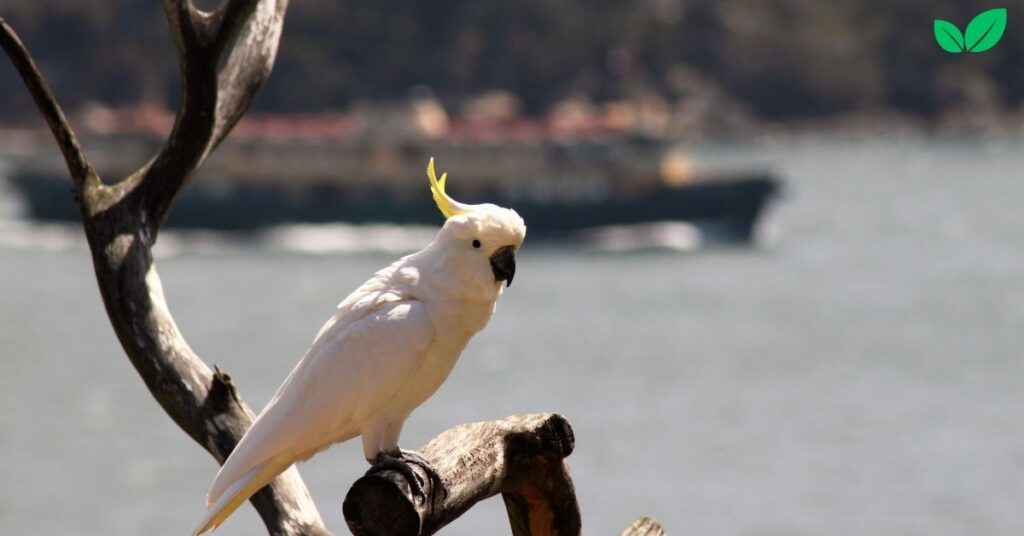
1. Mutualistic Relationships with Plants
Cacatua alba has a mutualistic relationship with the plants that provide its food. As the cockatoo consumes fruits and seeds, it disperses seeds across the forest, aiding in the reproductive success of various plant species. This mutually beneficial relationship supports both the cockatoo, which gains sustenance, and the plants, which rely on birds and other animals for seed dispersal.
Some plants have evolved specific traits to attract seed dispersers like the White Cockatoo, producing brightly colored fruits that stand out against the green foliage. These adaptations maximize the chances of successful seed dispersal, enhancing the resilience and genetic diversity of the plant populations within the forest.
2. Competition with Other Frugivorous Birds
The White Cockatoo competes with other frugivorous (fruit-eating) birds, such as hornbills and parrots, for access to fruits, seeds, and other resources. This competition helps regulate cockatoo populations and promotes resource sharing within the ecosystem, preventing any one species from monopolizing food sources.
Competition also encourages the White Cockatoo to explore different food sources and foraging areas, which supports a diverse ecosystem. By balancing the resource needs of multiple frugivorous species, the White Cockatoo helps create a stable community where a variety of species can coexist and support one another.
3. Predator-Prey Relationships with Birds of Prey
As a relatively large bird, the White Cockatoo has few natural predators, but it is sometimes hunted by larger birds of prey, such as hawks and eagles, as well as by snakes. These predators help regulate cockatoo populations, preventing them from becoming overly abundant and impacting the availability of resources for other species.
In response to predation, the White Cockatoo has developed certain behaviors, such as nesting in concealed locations and foraging in groups. These behaviors enhance its chances of survival and demonstrate the adaptability of the species within its complex ecosystem.
Conservation Challenges Facing Cacatua Alba
Despite its resilience, Cacatua alba faces various conservation challenges due to habitat loss, illegal pet trade, and human activities. These threats impact its populations and the health of the ecosystems it supports, making conservation efforts essential to ensure its survival.
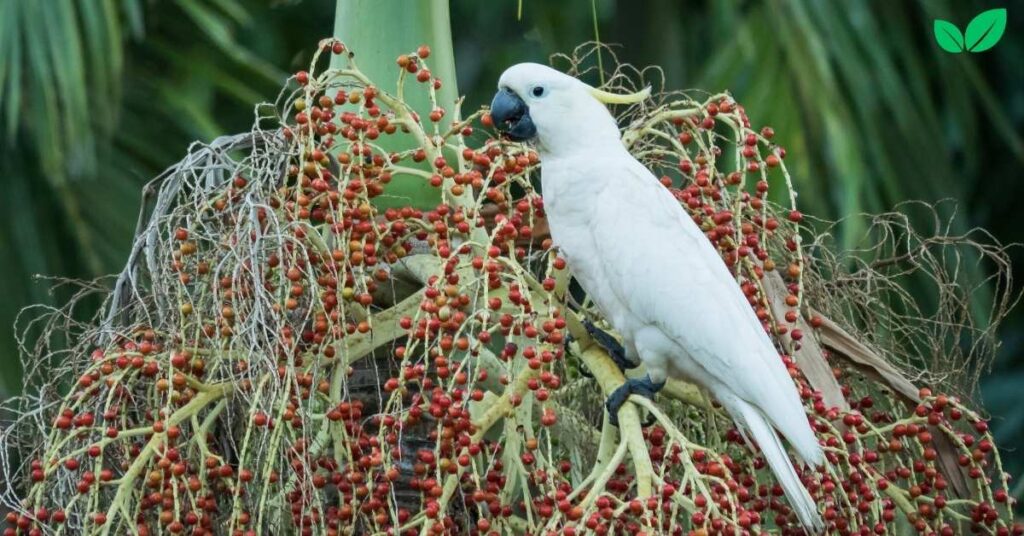
1. Habitat Loss and Deforestation
Deforestation is one of the primary threats to the White Cockatoo, as large areas of tropical rainforest are cleared for agriculture, logging, and development. The loss of mature trees, which provide nesting and food sources, has a direct impact on cockatoo populations, limiting their ability to breed and find adequate shelter.
To protect White Cockatoo populations, efforts to preserve rainforest habitats and establish protected areas are essential. By conserving forested landscapes, we can provide cockatoos with the resources they need to thrive, supporting the overall health of tropical ecosystems.
2. Illegal Pet Trade
The illegal pet trade is a significant threat to Cacatua alba, as their striking appearance and charismatic behavior make them popular pets. Many wild cockatoos are captured and sold into the pet trade, leading to population declines and disrupting social structures within their natural habitat.
Stricter regulations on the capture and sale of White Cockatoos, along with awareness campaigns to reduce demand, are crucial for protecting wild populations. Conservation organizations and governments play an important role in combating the illegal pet trade and supporting sustainable practices that prioritize the welfare of these birds.
3. Human Disturbance and Environmental Stress
Human activity, including habitat fragmentation, pollution, and noise, can cause environmental stress for White Cockatoos, affecting their health and reproductive success. Disturbance from tourism or development projects near nesting sites can impact the birds’ ability to reproduce and raise their young.
Conservation strategies that minimize human disturbance in critical habitats and promote responsible tourism are essential for protecting White Cockatoo populations. By reducing human impact on their natural habitats, we can help ensure that these birds have safe environments in which to thrive.
Conclusion
Cacatua alba, or the White Cockatoo, is a striking and ecologically valuable species that plays an essential role in tropical rainforest ecosystems. With its unique adaptations, social behaviors, and contributions to seed dispersal, nutrient cycling, and biodiversity, the White Cockatoo is a keystone species within its habitat. Its interactions with plants, competition with other frugivores, and position in the food web contribute to the balance and resilience of tropical ecosystems.
However, the cacatua alba faces significant conservation challenges, including habitat loss, illegal pet trade, and environmental stress. Protecting its natural habitats, regulating trade, and promoting conservation awareness are essential steps toward ensuring the survival of this remarkable bird. By understanding and preserving Cacatua alba, we contribute to the health and diversity of tropical rainforests and support the resilience of ecosystems that depend on this iconic species.
FAQs
1. Why is Cacatua alba also called the Umbrella Cockatoo?
Its nickname comes from the bird’s crest, which fans out like an umbrella when it is raised, creating a striking visual effect.
2. Where does the cacatua alba live?
It is native to Indonesia’s Maluku Islands, where it inhabits tropical rainforests, lowland forests, and mangrove areas.
3. How does the cacatua alba contribute to forest health?
It disperses seeds of various plants, aiding in forest regeneration, biodiversity, and ecosystem stability.
4. What are the main threats to White Cockatoo populations?
Threats include habitat loss due to deforestation, the illegal pet trade, and environmental disturbance from human activity.
5. How does the cacatua alba support biodiversity?
By dispersing seeds, controlling insect populations, and acting as prey, it contributes to food webs and ecosystem balance.
6. How can we help conserve the White Cockatoo?
Protecting its habitat, reducing the illegal pet trade, and promoting conservation efforts are key to its protection.
Read More: Doctor Bird: Exploring Its Environmental Niche and Ecological Importance

